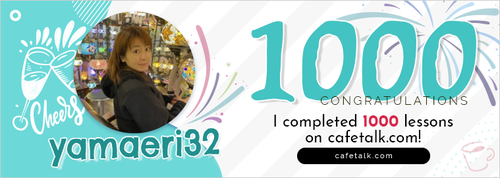Lesson Categories
Language Fluency
| Japanese | Native |
|---|---|
| Japanese Sign Language | Native |
| American Sign Language | Just a few words |
| English | Just a few words |
Tutor Stats
1,212
Lessons
134
Students
Less than 3 hours
Response
No Short-Notice
Cancellations
for last 3M
Cancellations
for last 3M
NDA
accepted
Video
Camera
Camera
using
15 hours ago
logged in
Lesson offered using...
Available Times
This tutor usually accepts requests up to 24 hours before the desired lesson time
Schedule visible to 0.5 month(s)
Actual availability may differ. Please check when you make a request.
Shown in Asia/Tokyo time.
Tutor’s Columns
Columns from this tutor to Cafetalk students.
こんにちは、yamaeri32です。先日、神保町の古本まつりに行ってきました。(祭りは11月3日まで続きます)第63回というので、結構歴史がある祭り。夕方から多くの客で賑わってて、古本に興味がある人...
こんにちは!yamaeri32です。10月14・15日、21日は第18回全国手話検定が開催されます。私は3〜5級の面接官として務めました!今年の5級受講生は全体的にレベルが高かったです。 コロナ禍を...
yamaeri32 Tutor Profile

It has been four years since I have been working as an interviewer for the National Sign Language Proficiency Test, in addition to teaching a training course for sign language service personnel sponsored by the Ministry of Health, Labor and Welfare.
What I feel now is that the number of TV dramas featuring sign language have become more common, and with the broadcast of “Silent” last year and princess Kako’s speech in sign language, the number of people who want to learn sign language seems to have increased as well. There was a sign language drama starring actor Kusanagi in December 2023, and although there used to be a strong tendency to “learn sign language to help the deaf,” it seems that the trend has completely changed now and more and more people “want to learn sign language for their own sake” and because it’s “fun for them.”
When I ask my students why they, they often reply, “after learning sign language, I understood the importance of face to face conversation,” and “I learned that facial expressions are also important.”
It would be a great pleasure if, through sign language, people could feel the “importance of communication” regardless of whether they are deaf or hearing.
As a tutor, one of the most common struggles I hear is that people want to learn sign language, but they don’t have anyone to practice it with.
The number of native signers is quite limited.
It is estimated that congenitally deaf people make up 0.1% of the total population. In Japan, it is estimated that there are around 120,000 people, but even fewer use sign language as their native language due to the environment they grew up in, including their household and schools. (Perhaps an estimate of 60,000? or maybe even less _)
I would love to help people who want to learn sign language but don’t know where to start because they don’t know anyone who speaks sign language, as much as I can.
【Introduction】
For those who are completely new to sign language, I will teach the following topics!
・What kind of language is sign language?
・First, let’s try to imitate the tutor’s hand movements (very important)
・Learn how to introduce yourself.
【Beginner】
Why not join me to have fun learning the basics?
・Learn to be able to have a simple conversation
・Learn to express and read finger letters.
・Learn words that are often used in daily life.
【Intermediate】
If you think you understand sign language a little, why not aim to advance to the next level!
・Be able toread and express finger signs almost perfectly.
・Be able to have daily conversation without speaking out loud.
(Since I cannot hear, the goal here is to be able to have daily conversations in sign language without using the chat function)
【Preparation for the National Sign Language Proficiency Test】
The National Sign Language Proficiency Test is held once or twice a year, and includes an interview in which you have to speak in sign language, but many applicants get extremely nervous.
I would like to help you relieve your nervousness by giving you some interview tips in advance.
【 Cafetalk Translation / January 2024 】
Please note that this profile has been translated by Cafetalk for easier understanding. The tutor doesn’t speak English.
This tutor's cancellation policy
Before request is confirmed (fixed)
- Cancellation possible at any time without charge.
After request is confirmed (fixed)
- Less than 6hours before lesson start time.→ 100% of price charged.
- Between 6-12hours before lesson start time.→ 50% of price charged.
- No-Show→ 100% of price charged.
Lessons by this tutor
-




Chat in Sign Language (3-lesson set)
This lesson is aimed for those who just want to chat in sign language. It might not be suitable for those who want to learn proper grammar. ✳︎When booking a lesson, please list multiple topics you’d like to talk about.25min X 3 3,300PPack of 3 -
-




Beginner Course
This course is for beginners and those learning sign language for the first time. You can continue learning in this course until you can hold basic-level daily conversations.25min X 6 7,800PHas Trial Pack of 6 -




Build Your Skills (25 minutes) 4-Lesson Set
Intended for those who can already handle daily conversation and are aiming to further build their skills.25min X 4 5,700PPack of 4 -
-
-
-
-
Feedback from students
-

-
 Courteous and thorough For beginners Caters to your level
Courteous and thorough For beginners Caters to your level -
 Friendly Good for in-depth study Professional
Friendly Good for in-depth study Professional -
 Good for in-depth study Courteous and thorough Friendly
Good for in-depth study Courteous and thorough Friendly -
 Good for in-depth study For beginners Content rich
Good for in-depth study For beginners Content rich






***ile